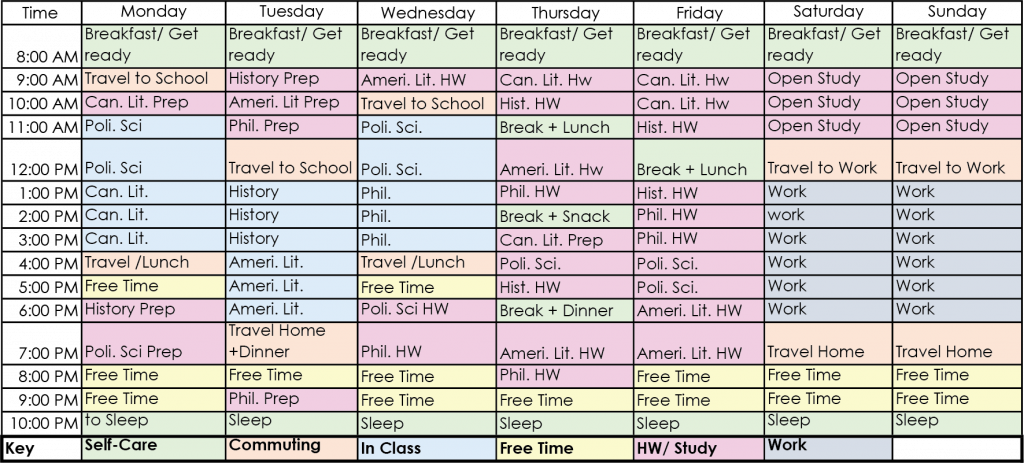17
The Primary Time Management Tool is PLANNING. A phrase that supports this notion is Planning Sets You Free. [1] How does planning set you free and from what does it set you free? When you have lots to do in a specific period of time, you are often saddled with worry and fear that it may not get accomplished. That added worry can easily turn into stress which can hurt your ability to perform well and get things done. Planning liberates you from this worry and makes you more confident in your ability to accomplish tasks. Wedding planners exist because they help organize and take care of things, reducing worries and leading to more confidence that the event will turn out well. Similarly, good planning in other aspects of life, especially school, can greatly benefit from the fruits of good planning. Planning should be based on the goals you want to achieve, ensuring that the outcomes of your planning will lead you to fulfilling your goals.
Use planning to get you started with scheduling your tasks. Your next step is to create a weekly schedule. This will include your class times and any regularly schedule commitments. A weekly schedule is a good tool to evaluate whether your time use allows you to meet your overall goals. Do you have enough time for study? Is there time to maintain a healthy lifestyle?
The following principles will guide you as you create your weekly schedule:
- Record class and lab times in appropriate day/hour blocks on a time schedule sheet.
- Record travel times to and from the university and between classes.
- Record meal times, family times, laundry times, etc.
- Record all regularly scheduled personal activities such as meetings, employment and athletics.
- Record any special activities you need to do or want to do on a regular basis.
- Schedule a preview time (30 minutes) immediately before each class whenever possible. During the preview, review all or some of your notes in preparation for the upcoming class. If you have two or three classes in a row, preview from last to first class.
- Schedule a review time immediately after your classes (30 minutes) whenever possible. Use this time to edit and summarize your notes. You can also look over any assignments that were given and begin to plan when and how you will do them.
- Schedule intensive pre-reading / study / review time for each class. Try to schedule some study time each day for each class. Learning is more effectively and efficiently accomplished in shorter regular sessions than in longer irregular sessions. Also, use more of the day (i.e. morning, afternoon) for studying. Pick the times of days when you are most alert.
- Schedule to start your study period with the courses you like least or that you’re not doing well in. Try to study the same subjects at the same time each study day. Although this seems to be a mechanical way of scheduling, you will find that such a routine can help you develop a pattern for efficient and effective learning.
- Schedule a weekly review (WR) for each course. Do it at the end of the week if possible. This weekly review gives you an opportunity to go over the past week’s notes along with the reading assignments to see what you have been learning in the past week during class and study time for each course. You can also look ahead to plan the next week and determine how much reading you need to do, what projects are due, and if any tests are scheduled.
- Keep open some time for daily physical activity. Remember, research indicates that regular exercise will not only give you a general sense of well-being, but can reduce tension and help you accomplish a tough class, study, and work schedule.
- Label some empty blocks of time as OPEN for academic or personal needs.
- Schedule some time during Friday, Saturday, and Sunday for you to play, relax, or do whatever you want to do. This is your reward for sticking to your schedule. In addition, you’ll enjoy your free time more. Because it is scheduled you do not need to feel guilty.
Here is an example of what a completed weekly schedule might look like:

Try it!
Create your weekly schedule for this semester following the principles you have just learned. Follow your schedule as you have created it for two weeks. After two weeks, make any adjustments necessary. Perhaps you need more time to study for a difficult class, or perhaps you would like to add a recreational activity to maintain a good life balance.
Download a printable weekly schedule.
| Time | Monday | Tuesday | Wednesday | Thursday | Friday | Saturday |
| 7:30-8:00 | ||||||
| 8:00-8:30 | ||||||
| 8:30-9:00 | ||||||
| 9:00-9:30 | ||||||
| 9:30-10:00 | ||||||
| 10:00-10:30 | ||||||
| 10:30-11:00 | ||||||
| 11:00-11:30 | ||||||
| 11:30-12:00 | ||||||
| 12:00-12:30 | ||||||
| 12:30-1:00 | ||||||
| 1:00-1:30 | ||||||
| 1:30-2:00 | ||||||
| 2:00-2:30 | ||||||
| 2:30-3:00 | ||||||
| 3:00-3:30 | ||||||
| 3:30-4:00 | ||||||
| 4:00-4:30 | ||||||
| 4:30-5:00 | ||||||
| 5:00-5:30 | ||||||
| 5:30-6:00 | ||||||
| 6:00-6:30 | ||||||
| 6:30-7:00 | ||||||
| 7:00-7:30 | ||||||
| 7:30-8:00 | ||||||
| 8:00-8:30 | ||||||
| 8:30-9:00 | ||||||
| 9:00-9:30 |
Licenses and Attributions:
Content previously published in University 101: Study, Strategize and Succeed by Kwantlen Polytechnic University, licensed as CC BY-SA.
Adaptations: Added introduction on planning
- Adapted from Ellis, Dave, (2006), Becoming a Master Student, Cengage Learning ↵
